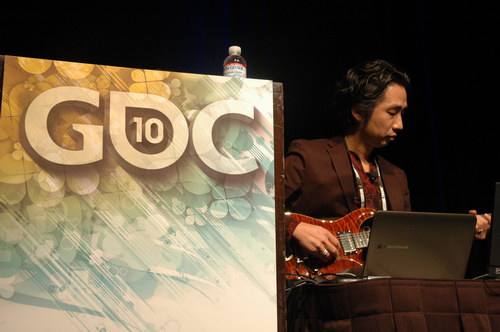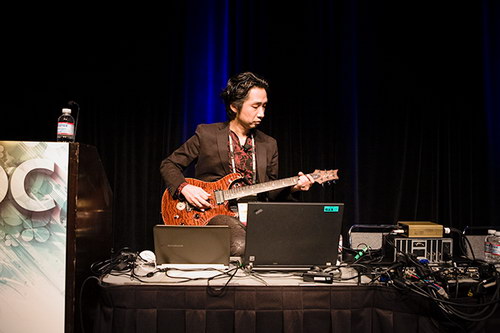Silent Hill composer tunes into perfect soundDate published: 2010.03.11 GDC 2010: Akira Yamaoka of Grasshopper Manufacture discusses how the human brain works and what techniques are effective when creating a memorable audio experience.

Who Was There: Akira Yamaoka, who is best known for his music in the Silent Hill series, leveraged his 20 years of experience in video game production to discuss audio design in games from a producer's perspective. He has worked not only as a composer, but also as a sound designer, sound director, and producer. Having recently left longtime employer Konami, Yamaoka is currently working with Suda51 on a new game at Grasshopper Manufacture that will be published by EA Partners. What They Talked About: Yamaoka's 2010 Game Developers Conference session began with a few slides that highlighted some facts of Japan, including the number of islands (6,852) and coastal line (comparable to that of Australia). Yamaoka wanted go over his background and heritage because the kind of attention to detail that is part of the Japanese culture ties in closely to what he ultimately strives for: perfection. "We care about details. That's the culture," he said through a translator. "We are married to perfection, to details. I hope that links with the world of games." Yamaoka wanted to be a designer after entering the world of computer games. Computer graphics were still considered new at the time, and his original goal was to focus on graphics but then switched after he bought a PC. "I wasn't very serious and was having fun," he explained. "I discovered that with a computer, you can compose music, so I switched to [make] computer music instead of computer graphics." Currently, Yamaoka uses MAX/MSP to compose, but the interface wasn't as accessible 20 years ago. He says that nowadays, anyone can create music, but for him it's a matter of going beyond that. Comparisons were made to film, but he stated that drama films don't have the same interactive communication that video games do. The composer went on to discuss how humans rely on visuals for stimulation but what he wanted to do was find a way to stimulate or "tickle" a player's emotion with sound. Because humans have other senses as well, he hoped that later down the road, gamers can be "tickled" by taste and scents as well. Yamaoka's theory for controlling a person's emotions is based around psychology. He explained how humans feel unstable when they turn clockwise and that there's a psychological uncertainty there. Understanding what humans naturally fear is something that is used in games to create anxiety. Having worked on the Silent Hill series since its inception, Yamaoka talked about how he would bring in sound three frames ahead to induce intensity or anxiety. The opposite would result when audio comes after the visual cues, which instead provide security and comfort. Contrasting sounds also leave a lasting impression on a listener. An example that he used was to introduce a beautiful piano melody, followed by a frightening sound. Each sound becomes more vivid and the same trick is used in visuals as well. Based on Yamaoka's audio research, he explained that when the brain hears a sound that is followed by silence, the sound remains even after it has been cut off, which leaves a powerful impact on the listener. "It's the lack of sound that impresses humans more than the beautiful music," he said.

The final part of Yamaoka's talk was focused on the MAX audio software and how simple it was for him to use when composing and creating sounds. To demonstrate, he brought out his electric guitar and played for several minutes. At the end of the presentation, he left the audience with a quote from his favorite architect, Ludwig Mies van der Rohe, who said, "God is in the detail of the arts." He feels that to achieve what he wants, it's in the details and through that, originality and uniqueness can be delivered. Quote: "God is in the detail of the arts."–Akira Yamaoka, quote originally by famous architect Ludwig Mies van der Rohe. Takeaway: Silence can often be more effective than noise, depending on how it is used. Understanding how humans digest and process sound can help audio designers create something that is more powerful and memorable. |
